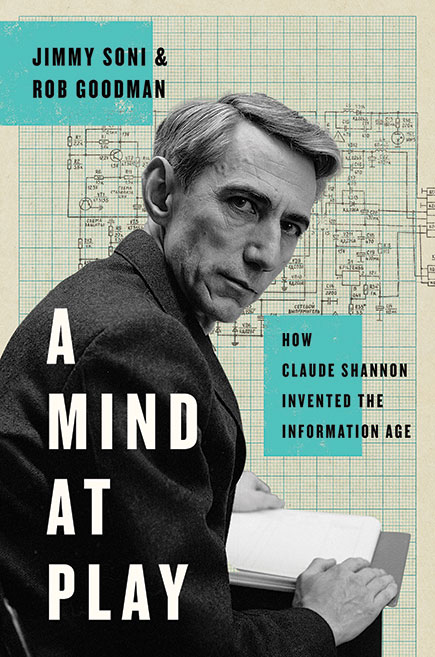Digital Joy

Claude Shannon somewhat famously built an electromechanical maze-solving robotic mouse named Theseus. But readers of his first biography, A Mind at Play: How Claude Shannon Invented the Information Age, may be surprised to learn that he built juggling robots, a 35-foot-long swing, and a squadron of unicycles as well. He also invented a flame-throwing trumpet and Styrofoam shoes for walking on water. And he built a machine that, when turned on, simply turns itself back off—with, as science fiction author Arthur C. Clarke described it, “an angry, purposeful buzzing.”
Shannon’s career is marked by a brave playfulness and a refusal to specialize. Though he’s best known for laying out the mathematical foundation of digital information storage and transmission, the heart of modern computers and communication, he later studied the mathematics of juggling, built perhaps the first wearable computer, and wrote the first paper on computer chess. Authors Jimmy Soni and Rob Goodman say that cultivating such broad creativity helped Shannon merge languages of previously disparate fields, applying symbolic logic to genetics, Boolean logic to circuit design, and linguistics to cryptography.
To write the book, the authors applied inspiration from its subject, noting that Shannon “never took the fact that he didn’t have expertise in the field as an excuse not to learn something.” In half a decade of research, they pored over half a century of stories from Shannon’s hometown newspaper and 21 boxes of his papers, interviewed loved ones and contemporaries, and visited some of the places that, as they put it, “occupied his life and his time.”
Those places, say Soni and Goodman, were instrumental in helping him flourish. His mentors recognized his talents from the outset, stretching his horizons and giving him freedom to pursue his interests. His discoveries came in settings like Bell Labs (in whose long hallways he would often spend his workdays juggling on a unicycle), his expansive home workshop, and MIT, where he earned both a master’s and a PhD in 1940 and later returned to teach mathematics “as a fellow traveler and problem solver.” He found plenty of like-minded problem solvers at MIT, where students still like to amuse themselves by, say, building temporary roller coasters, data-mining their in-boxes, or creating and destroying battlebots.
There is something extraordinarily cheering about the idea that the mathematical infrastructure of the digital world was invented by someone who was just as eager to build a walking Erector Set turtle or improvise on the clarinet alongside a jazz record. As Soni and Goodman write: “Maybe it is too much to presume that the character of an age bears some stamp of the character of its founders; but it would be pleasant to think that so much of what is essential to ours was conceived in the spirit of play.”
Recent Books
From the MIT Community
A Mind at Play: How Claude Shannon Invented the Information Age
By Jimmy Soni and Rob Goodman
Simon & Schuster, 2017, $27
Life 3.0: Being Human in the Age of Artificial Intelligence
By Max Tegmark, professor of physics
Knopf, 2017, $28
Rebel Power: Why National Movements Compete, Fight, and Win
By Peter Krause, PhD ’11, research affiliate, MIT Security Studies Program
Cornell University Press, 2017, $24.95
Faster, Smarter, Greener: The Future of the Car and Urban Mobility
By Venkat Sumantran; Charles Fine, professor at MIT Sloan; and David Gonsalvez, CEO of MIT’s Malaysia Institute for Supply Chain Innovation
MIT Press, 2017, $29.95
Physical and Biological Hazards of the Workplace, 3rd Edition
Edited by Gregg M. Stave ’79 and Peter H. Wald
Wiley, 2016, $149.95
In-Flight Simulators and Fly-by-Wire/Light Demonstrators: A Historical Account of International Aeronautical Research
Edited by Peter G. Hamel, SM ’65; translated by Ravindra V. Jategaonkar
Springer, 2017, $179
Areas of Fog
Will Dowd, SM ’07
Etruscan Press, 2017, $15
Public Space? Lost and Found
Edited by Gediminas Urbonas, associate professor of architecture and director of the Program in Art, Culture, and Technology (ACT); Ann Lui, SM ’15; and Lucas Freeman, ACT’s writer in residence
SA+P Press, 2017, $40
Please submit titles of books and papers published in 2016 and 2017 to
be considered for this column.
Contact MIT News
E-mail mitnews@technologyreview.com
Write MIT News, One Main Street, 13th Floor, Cambridge, MA 02142
Keep Reading
Most Popular
Large language models can do jaw-dropping things. But nobody knows exactly why.
And that's a problem. Figuring it out is one of the biggest scientific puzzles of our time and a crucial step towards controlling more powerful future models.
The problem with plug-in hybrids? Their drivers.
Plug-in hybrids are often sold as a transition to EVs, but new data from Europe shows we’re still underestimating the emissions they produce.
Google DeepMind’s new generative model makes Super Mario–like games from scratch
Genie learns how to control games by watching hours and hours of video. It could help train next-gen robots too.
How scientists traced a mysterious covid case back to six toilets
When wastewater surveillance turns into a hunt for a single infected individual, the ethics get tricky.
Stay connected
Get the latest updates from
MIT Technology Review
Discover special offers, top stories, upcoming events, and more.